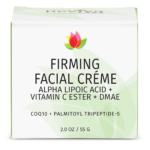Stearic Acid
A white, waxy, fatty acid from tallow, butter acids, animal fats or vegetable oils. It is used in cosmetic creams for the pearliness and firmness provided. Allergic reactions to this chemical are common.
Stearic acid (/ˈstɪərɪk/ STEER-ik, /stiˈærɪk/ stee-ARR-ik) is a saturated fatty acid with an 18-carbon chain. The IUPAC name is octadecanoic acid. It is a waxy solid and its chemical formula is C17H35CO2H. Its name comes from the Greek word στέαρ "stéar", which means tallow. The salts and esters of stearic acid are called stearates. As its ester, stearic acid is one of the most common saturated fatty acids found in nature following palmitic acid. The triglyceride derived from three molecules of stearic acid is called stearin.

| |

| |
| Names | |
|---|---|
| Preferred IUPAC name
Octadecanoic acid | |
| Other names
Stearic acid
C18:0 (Lipid numbers) | |
| Identifiers | |
3D model (JSmol)
|
|
| ChEMBL | |
| ChemSpider | |
| DrugBank | |
| ECHA InfoCard | 100.000.285 |
| EC Number |
|
| KEGG | |
PubChem CID
|
|
| RTECS number |
|
| UNII | |
CompTox Dashboard (EPA)
|
|
| |
| Properties | |
| C18H36O2 | |
| Molar mass | 284.484 g·mol−1 |
| Appearance | White solid |
| Odor | Pungent, oily |
| Density | 0.9408 g/cm3 (20 °C) 0.847 g/cm3 (70 °C) |
| Melting point | 69.3 °C (156.7 °F; 342.4 K) |
| Boiling point | 361 °C (682 °F; 634 K) decomposes 232 °C (450 °F; 505 K) at 15 mmHg |
| 0.00018 g/100 g (0 °C) 0.00029 g/100 g (20 °C) 0.00034 g/100 g (30 °C) 0.00042 g/100 g (45 °C) 0.00050 g/100 g (60 °C) | |
| Solubility | Soluble in alkyl acetates, alcohols, HCOOCH3, phenyls, CS2, CCl4 |
| Solubility in dichloromethane | 3.58 g/100 g (25 °C) 8.85 g/100 g (30 °C) 18.3 g/100 g (35 °C) |
| Solubility in hexane | 0.5 g/100 g (20 °C) 4.3 g/100 g (30 °C) 19 g/100 g (40 °C) 79.2 g/100 g (50 °C) 303 g/100 g (60 °C) |
| Solubility in ethanol | 1.09 g/100 mL (10 °C) 2.25 g/100 g (20 °C) 5.42 g/100 g (30 °C) 22.7 g/100 g (40 °C) 105 g/100 g (50 °C) 400 g/100 g (60 °C) |
| Solubility in acetone | 4.73 g/100 g |
| Solubility in chloroform | 15.54 g/100 g |
| Solubility in toluene | 13.61 g/100 g |
| Vapor pressure | 0.01 kPa (158 °C) 0.46 kPa (200 °C) 16.9 kPa (300 °C) |
| −220.8·10−6 cm3/mol | |
| Thermal conductivity | 0.173 W/m·K (70 °C) 0.166 W/m·K (100 °C) |
Refractive index (nD)
|
1.4299 (80 °C) |
| Structure | |
| B-form = Monoclinic | |
| B-form = P21/a | |
| B-form = Cs 2h | |
a = 5.591 Å, b = 7.404 Å, c = 49.38 Å (B-form) α = 90°, β = 117.37°, γ = 90°
| |
| Thermochemistry | |
Heat capacity (C)
|
501.5 J/mol·K |
Std molar
entropy (S⦵298) |
435.6 J/mol·K |
Std enthalpy of
formation (ΔfH⦵298) |
−947.7 kJ/mol |
Std enthalpy of
combustion (ΔcH⦵298) |
−11342.4 kJ/mol |
| Hazards | |
| NFPA 704 (fire diamond) | |
| Flash point | 113 °C (235 °F; 386 K) |
| Lethal dose or concentration (LD, LC): | |
LD50 (median dose)
|
4640 mg/kg (rats, oral) 21.5 mg/kg (rats, intravenous) |
Except where otherwise noted, data are given for materials in their standard state (at 25 °C [77 °F], 100 kPa).
| |










